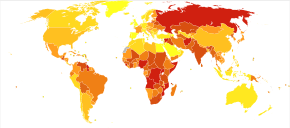Injury
Injury, also known as physical trauma, is damage to the body caused by external force.[1] This may be caused by accidents, falls, hits, weapons, and other causes.[1] Major trauma is injury that has the potential to cause prolonged disability or death.
| Injury | |
|---|---|
| The knee of a person is examined with the help of radiography after an injury. | |
| Specialty | Emergency medicine, traumatology |
In 2013, 4.8 million people world-wide died from injuries, up from 4.3 million in 1990.[2] More than 30% of these deaths were transport-related injuries.[2] In 2013, 367,000 children under the age of five died from injuries, down from 766,000 in 1990.[2] Injuries are the cause of 9% of all deaths, and are the sixth-leading cause of death in the world.[3][4]
Classification


The World Health Organization (WHO) developed the International Classification of External Causes of Injury (ICECI). Under this system, injuries are classified by:
- mechanism of injury;
- objects/substances producing injury;
- place of occurrence;
- activity when injured;
- the role of human intent;
and additional modules. These codes allow the identification of distributions of injuries in specific populations and case identification for more detailed research on causes and preventive efforts.[5][6]
The United States Bureau of Labor Statistics developed the Occupational Injury and Illness Classification System (OIICS). Under this system injuries are classified by
- nature,
- part of body affected,
- source and secondary source, and
- event or exposure.
The OIICS was first published in 1992 and has been updated several times since.[7]
The Orchard Sports Injury Classification System (OSICS) is used to classify injuries to enable research into specific sports injuries.[8]
By cause
By modality
- Traumatic injury, a body wound or shock produced by sudden physical collision or movement[9]
- Repetitive strain injury or other strain injury
- Other injuries from external physical causes, such as radiation poisoning, burn, or frostbite
- Injury from toxin or as adverse effect of a pharmaceutical drug
- Injury from internal causes such as reperfusion injury
By location
- Wound, an injury in which skin is torn, cut or punctured (an open wound), or where blunt force trauma causes a contusion (a closed wound). In pathology, it specifically refers to a sharp injury which damages the dermis of the skin.
- Brain injury
- Nerve injury
- Spinal cord injury
- Brachial plexus injury
- Peripheral nerve injury
- Sciatic nerve injury
- Injury of axillary nerve
- Soft tissue injury
- Penile strangulation
- Cell damage, including direct DNA damage
- Lisfranc injury
- Tracheobronchial injury
- Eye injury
- Acute kidney injury
- Knee injury
- Back injury
- Hand injury
- Liver injury
- Head injury
- Penetrating head injury
- Closed head injury
- Musculoskeletal injury
- Articular cartilage injuries
- Acute lung injury
- Pancreatic injury
- Thoracic aorta injury
- Biliary injury
- Chest injury
- Asphyxia
By activity
Injury severity score
The injury severity score (ISS) is a medical score to assess trauma severity.[10][11] It correlates with mortality, morbidity, and hospitalization time after trauma. It is used to define the term major trauma (polytrauma), recognized when the ISS is greater than 15.[11] The AIS Committee of the Association for the Advancement of Automotive Medicine designed and updates the scale.
See also
References
- "Wounds and Injuries: MedlinePlus". Nlm.nih.gov. Retrieved 2015-07-20.
- GBD 2013 Mortality and Causes of Death, Collaborators (17 December 2014). "Global, regional, and national age-sex specific all-cause and cause-specific mortality for 240 causes of death, 1990-2013: a systematic analysis for the Global Burden of Disease Study 2013". Lancet. 385 (9963): 117–71. doi:10.1016/S0140-6736(14)61682-2. PMC 4340604. PMID 25530442.
- "The top 10 causes of death". Retrieved 24 May 2015.
- Stein DM, Santucci RA (July 2015). "An update on urotrauma". Current Opinion in Urology. 25 (4): 323–30. doi:10.1097/MOU.0000000000000184. PMID 26049876.
- "International Classification of External Causes of Injury (ICECI)". World Health Organization. Retrieved 2014-03-24.
- Robertson, LS (2015) Injury Epidemiology: Fourth Edition. Free online at www.nanlee.net
- "Occupational Injury and Illness Classification System". Centers for Disease Control and Prevention. Retrieved 2014-03-24.
- Rae, K; Orchard, J (May 2007). "The Orchard Sports Injury Classification System (OSICS) version 10". Clin J Sport Med. 17 (3): 201–04. doi:10.1097/jsm.0b013e318059b536. PMID 17513912.
- "Trauma". Dictionary.com. Dictionary.com, LLC. 2010. Retrieved 2010-10-31.
- Baker SP, O'Neill B, Haddon W, Long WB (1974). "The Injury Severity Score: a method for describing patients with multiple injuries and evaluating emergency care". The Journal of Trauma. 14 (3): 187–96. doi:10.1097/00005373-197403000-00001. PMID 4814394.
- Copes, W.S.; H.R. Champion; W.J. Sacco; M.M. Lawnick; S.L. Keast; L.W. Bain (1988). "The Injury Severity Score revisited". The Journal of Trauma. 28 (1): 69–77. doi:10.1097/00005373-198801000-00010. PMID 3123707.
External links
| Classification |
|---|
| Wikimedia Commons has media related to Wounds. |
| Wikiquote has quotations related to: Injury |
- International Trauma Conferences (registered trauma charity providing trauma education for medical professionals worldwide)
- Trauma.org (trauma resources for medical professionals)
- Emergency Medicine Research and Perspectives (emergency medicine procedure videos)
- American Trauma Society
- Scandinavian Journal of Trauma, Resuscitation and Emergency Medicine